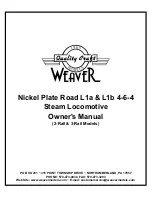
GRAUPNER GmbH & Co. KG
D-73230 KIRCHHEIM/TECK
GERMANY
We reserve the right to introduce modifications. No liability for printing errors.
02/2006
9
Cyano-acrylate (“cyano”) Order No. 5821
Wood to film
Wood to metal
UHU thread-lock fluid
Order No. 952
Metal threads
Tools:
1.5 mm Ø drill
2.0 mm Ø drill
Sawblade
Order No. 861 or 860
Cross-point and slot-head screwdrivers
1.5 mm A/F Allen key
Order No. 5735.1,5
Pliers
File
Tailplane and fin
Using a hot soldering iron, melt away the film over the slot in the top of the fuselage at the
tail end. Insert the fin, mark the line of the fuselage on both sides, then melt away the
excess film on the fin using the soldering iron again.
Glue the doublers to the tailplane using cyano, and attach it to the fuselage using the M4 x
20 round-head plastic screws supplied.
Glue the fin in the slot in the fuselage, checking that it is at right-angles to the tailplane.
Locate the opening in the tail end of the fuselage for the elevator linkage, and melt away
the film as already described. Attach the elevator to the tailplane using the patent hinges
supplied, and glue the hinges in place using cyano.
Cut down the elevator horn as shown, and bevel the horn spreader plate to provide proper
clearance.
Screw a clevis to the elevator pushrod, slip it into the guide tube from the tail end, and
connect it to the horn. Push a ring of silicone fuel tubing over the clevis to secure it. Find
the correct horn position on the elevator (the pushrod should not be under stress), and drill
2 mm Ø holes through the horn and elevator. Attach the horn using M2 screws which
engage in the spreader plate on the opposite side. Snip off the excess screw length and
file back flush.
Caution: hinge pivot line = linkage pivot point.
Cut down the servo output devices as shown. Drill out one inner hole and one outer hole of
the rudder / nosewheel output lever using a 2 mm Ø bit. Insert the screw-lock pushrod
connector from above, fit the self-locking nut on the underside and tighten it to the point
where the connector just swivels smoothly,
without
lost motion. Set the servos to centre
and fit the output arms on the servos.
Press the rubber grommets and tubular spacers into the servo mounting lugs and place
the servos in the openings in the fuselage. Screw a clevis on the front end of each pushrod
inside the fuselage. Position the servos in line with the pushrods, drill 1.5 mm Ø holes
through the mounting lugs, and fix the servos in place using the retaining screws supplied
with them.
Looking at the fuselage from the tail, the left-hand servo operates the rudder and
nosewheel, the right-hand servo the elevator. Set the servos to neutral by switching on the






























